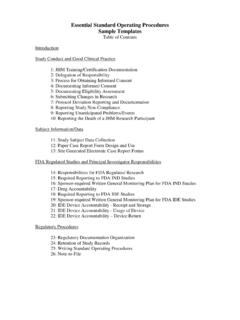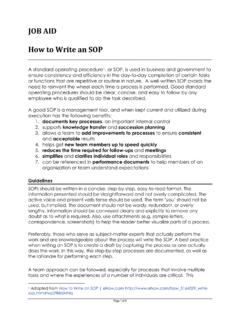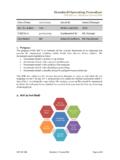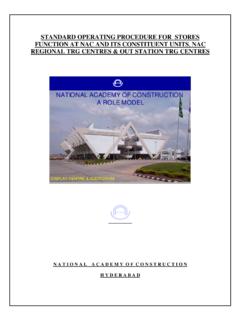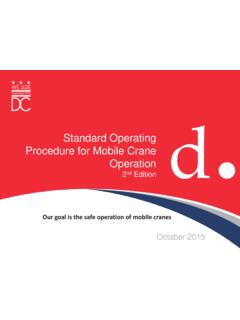Transcription of Standard Operating Procedure (SOP)
1 Centrifugation Standard Operating Procedure (SOP). This Standard Operating Procedure (SOP) describes basic chemical safety information for centrifugation. Prior to conducting work with a centrifuge personnel must obtain approval from their Principal Investigator (PI) and/or Supervisor and attend the appropriate laboratory safety training. The PI must complete the Lab- Specific Use procedures section and provide their personnel with a copy of this SOP. Print a copy of this SOP, sign it, and insert into your Safety on Site (SOS) Binder. Centrifugation Department: Date SOP was written: Date SOP was approved by PI/lab supervisor: Principal Investigator: Principal Investigator Signature: Internal Lab Safety Coordinator/Lab Manager: Lab Phone: Office Phone: Emergency Contact: (Name and Phone Number).
2 Location(s) covered by this SOP: (Building/Room Number). Type of SOP: [X] Process Hazardous Chemical Experiment Equipment Use Contents 1. Purpose and Scope of Work/Activity 8. Preventative Maintenance 2. Responsibility 9. Monitoring and Safety Systems 3. Specific Hazards and Controls 10. Waste Disposal/Cleanup 4. Hazard Control(s) 11. Emergency Response Plan 5. Location of Nearest Emergency Safety Equipment 12. References 6. Step-by-Step Operating Procedure 13. Additional Notes and Attachments 7. Special Handling procedures , Transport, and 14. Documentation of Training Storage Requirements Read and review any applicable manufacturer/vendor safety information before developing the Standard Operating procedures and performing work.
3 ** NOTE: Each section needs to be complete with clear and detailed information based on the blue/italic font instruction. SOP must be approved and dated by the PI or lab supervisor. SOP template 1 Revised: 06/2019 MTD. Centrifugation 1. Purpose and Scope of Work/Activity: The process of centrifuging samples is extremely useful and employed in a variety of laboratories. A. centrifuge spins samples at a high speed, the centrifugal force causes denser materials to travel to the bottom of the centrifuge tube rapidly. This allows for the separation of liquid and solid samples. The information below addresses general laboratory safety concerns while setting up and Operating a centrifuge. Modify this SOP with your laboratory's specific operational procedures with the help of the Principal Investigator and verify the SOP with EH&S approval prior to working with a centrifuge.
4 Ensure that the laboratory specific procedures outlined in this SOP are followed by laboratory workers at all times. This document is not designed to substitute hands-on training and supervision by experienced laboratory personnel. 2. Responsibility Identify the personnel that have primary roles in the SOP and describe how their responsibilities relate to this SOP. If necessary, include contact information. Principle Investigator Must provide their laboratory with a copy of this SOP, must sign this SOP, and ensure that all members of their laboratory sign and understand this SOP. Must ensure that their laboratory personnel have obtained the appropriate general laboratory safety training, laboratory specific training, and any refresher training.
5 Must ensure that trained personnel conduct repairs and maintenance on the centrifuge as needed. Laboratory Personnel Must obtain all necessary laboratory safety training, refresher training, and laboratory specific training. Must read, sign, understand, and follow this SOP when using the centrifuge. Must read the safety data sheet (SDS) for every compound that is being centrifuged. 3. Specific Hazards and Controls Chemical Hazards The chemical hazards vary depending on the experiment. Samples may be toxic, flammable, carcinogenic, pyrophoric, etc. All the necessary precautions for these compounds should be taken into account when conducting work with a centrifuge. Read the SDS for the compounds being used with a centrifuge.
6 List all of the specific chemicals typically used and their hazards. SOP template 2 Revised: 06/2019 MTD. Centrifugation Chemical/Material (Name, Cas #, Hazards GHS Symbol other ID). Health Exclamation Flame Hazard Mark Exploding Gas Cyliner Corrosion Bomb Flame Over Skull and Environment Circle Crossbones - highly flammable liquid and vapor Example: - harmful if swallowed Tetrahydrofuran - causes serious eye irritation (109-99-9) - may cause respiratory irritation - suspected of causing cancer Biological Hazards. Biological hazards vary depending on the biological agent and materials used. Centrifugation creates aerosols that can increase the risk of exposure to a hazardous agent or materials. Read the PSDS for the agents being used with a centrifuge.
7 Biological Agent (Name, ID) Hazards - falls under aerosol transmissible disease/pathogens Example: Herpes Simplex virus - transmitted via aerosols - may cause associated disease Hazards and Controls In general the main hazards and controls associated with centrifugation are: Risks and Hazards Controls Mechanical failure or Properly balance the centrifuge before using it. Examples of some strain appropriate methods are shown below. Centrifuged are most easily Centrifuge explosion balanced with container pairs that are placed directly across from each Uncontrolled movement other. SOP template 3 Revised: 06/2019 MTD. Centrifugation For buckets and adapters, load all of the buckets and adapters even if you are only using two out of four.
8 Ensure that they are properly balanced. Ensure that the centrifuge tubes are balanced by mass not by volume, always weight your tubes with the caps on (if you are capping the samples in the centrifuge) to ensure that they are balanced before centrifuging. The faster a centrifuge spins the more small differences in weight have an effect and lead to possible mechanical failure and centrifuge explosion. Therefore ultracentrifuges must be carefully balanced by weight since they run at extremely fast speeds. Never leave the centrifuge unattended until it is at the desired operational speed. Wait until the centrifuge gets to speed and observe if there are any signs of mechanical failure ( shaking, odd noises).
9 This type of failure usually occurs upon start up so it is imperative that you observe the instrument during that time. If the centrifuge starts to wobble, shake, or make an odd noise turn the centrifuge off immediately. Centrifuges will often vibrate when working, however if the centrifuge is wobbling or shaking something is wrong. Typically this is caused by user error ( not balancing the centrifuge properly), but it can also indicate mechanical failure. If mechanical failure of the centrifuge occurs, immediately turn the centrifuge off and unplug the power cable. Post a sign on the centrifuge to inform lab members that the machine is not working properly. Wait for a qualified service technician to inspect and repair the machine before using it.
10 Make sure that the rotor is in good working condition before using the centrifuge. Do not switch rotors, each centrifuge is equipped to handle a specific type of rotor and changing the rotor can led to mechanical failure. Always use a centrifuge on a level and firm surface, never use a centrifuge on an uneven or slanted surface. The centrifuge should be secured to the bench top by suction cups, wheel brakes, or another method. Always follow the operational instructions for the specific centrifuge that is being used. Never circumvent the safety features of the centrifuge. SOP template 4 Revised: 06/2019 MTD. Centrifugation Make sure that all parts of the centrifuge are in working condition prior to use.

